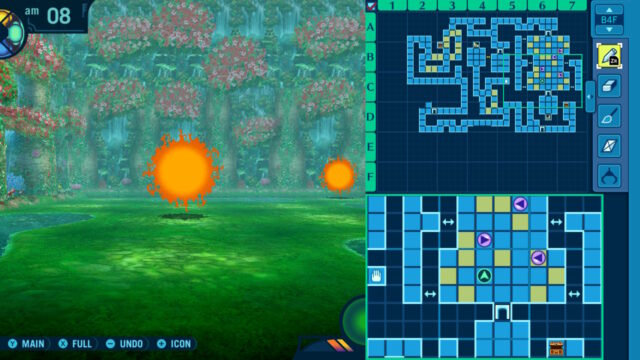Etrian Odyssey Origins Collection Deep Look
The collection can easily be recommended to both those that enjoy a good dungeon crawl… and to those that have spent some time away and would love to revisit the origins of the series.
First-person dungeon crawlers have been around since the 1970s and include historically famous series like Wizardry, Might and Magic, and Shin Megami Tensei. It wasn’t a genre that personally interested me though until I discovered a little Atlus title in 2007 called Etrian Odyssey. Over the course of the next dozen years, I steadfastly purchased, played, and enjoyed every subsequent entry, until the series ended with Etrian Odyssey: Nexus and the winding down of the dual-screen handheld era. Fast-forward four years and Atlus has brought the series back, this time to single-screen devices. The Etrian Odyssey Origins Collection on the Nintendo Switch consists of remasters of the first three Etrian Odyssey games — Etrian Odyssey HD, Etrian Odyssey II HD, and Etrian Odyssey III HD. They play like the original titles but with spruced-up HD graphics and new mapping systems that side-step the need for a second screen.
The general progression though all three Etrian Odyssey titles is basically the same. The story begins at a remote town that is located near a mysterious labyrinth that either reaches up into or delves deep below a nearby Yggdrasil tree. Teams of explorers have been coming to the town to try their hand at exploring the labyrinths and solving the mysteries held within. It’s up to the player to build a party of explorers and start dungeon crawling ever farther. Here’s where a bit of difference between the titles starts to appear. The further players go through the games in the Origins Collection, the more party customization options open up.
The first Etrian Odyssey has nine character classes to choose between, the second adds a few more for a total of twelve, while the third throws all those aside and offers a dozen all new classes to try. The third title also adds the ability for party members to have a sub-class after a certain story beat. Thankfully, players are not locked into their decisions in any game; the local Explorers Guild always allows for the creation of new characters, skill point reallocation, and even an option to retire a character in exchange for a new recruit with enhanced stats. Some of these come at the cost of experience levels, but having those options available allows for great trial-and-error customization.
Once parties are decided, it’s time for them to enter the labyrinth, where the vast majority of players’ time will be spent. The Etrian Odyssey games are all first-person dungeon crawlers. A party of up to five characters enters, moves through a gridded maze, and battles monsters as they try to navigate to the next level. These games progress slowly at first as healing is hard to come by and no money is obtained in battles, only the occasional monster part. With a strict inventory limit, players will find themselves returning to the hub town frequently during their adventure to sell off their spoils to unlock and purchase new equipment. There’s always a local bar or tavern in the hub city where parties can accept new sidequests once new dungeon floors are unlocked. Players are recommended to complete many of them as they provide money, equipment, and experience, all of which are in general, slowly doled out in these games.
Despite the slow pace of the games, Etrian Odyssey titles are not to be ignored by turn-based RPG fans. Each of the three titles are easily 50+ hour adventures when mainlining the story on standard difficulty, and those hours are filled with a very steady and tight sense of progression. Very little time will be spent solely on grinding if one makes the effort to fully explore each dungeon floor and complete a decent number of sidequests.
While most of the above could be said for the original Etrian Odyssey titles on the DS, the Origins Collection has its own features to talk specifically about. Presentation for all three titles has been measurably increased with sharp new HD graphics and a remastered soundtrack. The Yggdrasil labyrinths of each of the title have never looked better than they do in this collection, with detailed backgrounds and extremely smooth enemy sprites. Not only did series composer Yuzo Koshiro remaster the already excellent audio for all three titles, he even threw in an additional battle theme used in Etrian Odyssey III. The overall visual and audio presentation are excellent in both handheld and docked mode, a huge improvement over titles originally presented in a 256 x 192 resolution.

Players can explore in mapping mode where the map sits off to the side and can be manipulated by finger, stylus, or button presses.
A feature new to the Origins Collection is something later Etrian Odyssey titles had: difficulty levels. While the option to drop the difficulty to the easy Picnic level and speed things up does exist, most will likely want to spend a great deal more time exploring the sidequests and grinding their way through the Basic or Expert difficulties. Picnic takes any sense of danger from battle out of the equation, allowing even bosses to be felled with little to no strategy or healing needed. For a game series whose focus is on exploration and combat rather than story, having a de facto story mode is a bit odd. A difficulty level between the brutal Basic and too-easy Picnic would be welcome for those wanting a slightly less challenging adventure, but the ability to swap between difficulty levels while at the hub towns does allow for each short venture into the labyrinth to be customized.
The largest change made to the Etrian Odyssey Origins Collection by far is the mapping. This game series was born on the Nintendo DS and has always had two screens at its disposal before now, allowing players to draw their own labyrinth maps on the bottom screen. With the move to the Switch’s single screen, series fans might have figured that the dungeon mapping would have to be completely rethought. That only proved to be half true. The Origins Collection offers players two options on how to handle the dungeon mapping. Both methods allow the map to appear either on the right or left side of the screen based on the player’s preference or dominant hand usage. With a click of the X button, the labyrinth exploration view can compact to approximately 60% of its size and allow for dual maps to appear on the side. While the top map shows an overview of the entire floor, the bottom map consists of a 5×7 zoomed-in grid that allows players to draw on it. Drawing options are opened with the + or – buttons and provide dozens of icons and options for mapping. At this point players can use their finger or capacitive stylus to add to the map or use the ZR/ZL buttons and the analog sticks. Playing for dozens of hours, finger-mapping worked out amazingly well, and it was very easy to get used to using buttons instead for docked mode. Players really cannot go wrong choosing either option, and this bodes well for the continuation of the series on the Switch or similar single-screen successors.
Aside from the major changes and upgrades noted above, there are a bevy of tiny bug fixes, rebalancing, and quality-of-life improvements to all three games. Most are not worthy of individual mention nor will they be noticed except by the most detail-oriented Etrian Odyssey fan, but together they bring the first three games up to the standard of the more polished 3DS titles. The collection is a wonderful addition to any dungeon crawler fan’s must-play list. While the first two Etrian Odyssey games received 3DS remakes in Etrian Odyssey Untold: The Millennium Girl and Etrian Odyssey 2 Untold: The Fafnir Knight that have most of the improvements of these HD versions, with the closure of the 3DS eShop — and physical copies being the prices they are — these now are the most affordable and easily available versions. Etrian Odyssey III never received an Untold remake, so its inclusion in the collection is of special note. Each title is available individually or as a part of the full collection.
When the Etrian Odyssey Origins Collection was first announced back in February, I was initially somewhat interested in revisiting just the third title as it was the one never remade. As the release drew near though, the thought of seeing and hearing all of the titles in their new HD format got me increasingly excited. While I didn’t complete all 175+ hours of gameplay this full collection offers, there were multiple times sitting down to “try out” a game for a half-hour that turned into half a day of adventuring. The collection can easily be recommended to both those that enjoy a good dungeon crawl but have somehow missed this series previously, and to those that have spent some time away and would love to revisit the origins of the series.
Those interested in RPGamer’s thoughts on the original DS releases can check out previous reviews of Etrian Odyssey, Etrian Odyssey II: Heroes of Lagaard, and Etrian Odyssey III: The Drowned City.
Disclosure: This article is based on copies of the games provided by the publisher.








Recent Comments